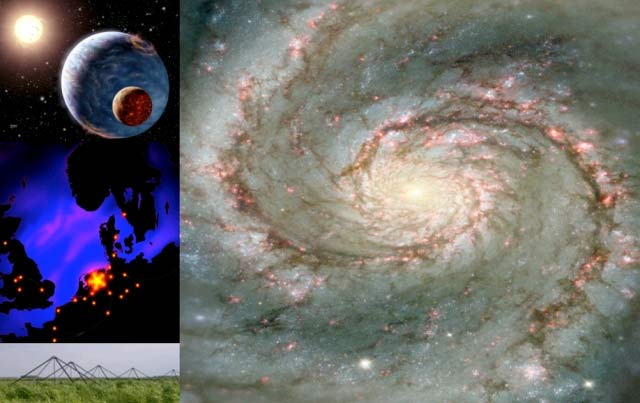New Telescope to Hunt for Aliens

Perhaps ET is just a solar system away, and perhaps all weneed is one more telescope to find him. That's the hope, at least, of somescientists who say a new radio observatory being built in Europe may hold achance of finding alien life beyond our planet.
The Low Frequency Array, or LOFAR,is a network of up to 25,000 small antennae beingbuilt in the Netherlands, Germany, Sweden, France and the United Kingdom. Thedistributed radio arrays will collectively scan the universe in the low radiofrequency of light when they are completed in 2009.
"LOFAR can extend the searchfor extraterrestrial intelligence to an entirely unexplored part of the low-frequencyradio spectrum, an area that is heavily used for civil and militarycommunications here on Earth," said Michael Garrett, general director ofASTRON, the Netherlands Institute for Radio Astronomy and professor of radiotechniques in astronomy at Leiden University in the Netherlands. "Inaddition, LOFAR can survey large areas of the sky simultaneously ? an importantadvantage if SETI signals are rare or transient in nature."
So far, the world?s most famousalien-hunting telescope, the Arecibo Observatory in Puerto Rico, has beenunsuccessful in locating extraterrestrials. The giant dish, which has beenlistening for radio waves since 1963, may even have to shut down in a few yearsif it can?t recover the funding lost since the National Science Foundationdecided to reduce its budget. LOFAR will scan a lower-frequency range of theelectromagnetic spectrum than Arecibo ? the very range in which we Earthlingsbroadcast television and radio signals. Some scientists hope that LOFAR offersthe chance to tune in to an alienversion of ?I Love Lucy.?
But others are skeptical of thissuggestion.
LOFAR will probably not besensitive enough to detect ET?s TV, unless the aliens are broadcasting with much morepowerful television transmitters than we have, said Seth Shostak, a seniorastronomer at the SETI Institute in California. He calculated that an alienversion of LOFAR would have to be at a distance of less than one light-yearaway from Earth to detect our television signals, which is closer than theclosest star.
Furthermore, broadcasting TV outinto space is already becoming pass? on Earth, where most of us get our signalthrough a cable in the wall, not rabbit ears on top of the set. Soon, we mayforego over-the-air broadcasting altogether.
Breaking space news, the latest updates on rocket launches, skywatching events and more!
?Presumably, ET has done all that, and to think that ETtelevision will still be broadcast into space the way we do, I think is being abit na?ve,? Shostak told SPACE.com. ?The chances that they?re at the same levelas us are very, very small.?
Still, to those who spend theirtime hunting and hoping for ET to finally phone home, any new tool that mightaid the quest is welcome, such as SETI@home, which allows people to donate theirpersonal computers? down time to the search.
?SETI searches are still only scratching the surface; we need to use asmany different telescopes, techniques andstrategies as possible, in order to maximize our chances of success,? said Dan Werthimer, SETI@homeproject scientist at the University ofCalifornia, Berkeley.

Clara Moskowitz is a science and space writer who joined the Space.com team in 2008 and served as Assistant Managing Editor from 2011 to 2013. Clara has a bachelor's degree in astronomy and physics from Wesleyan University, and a graduate certificate in science writing from the University of California, Santa Cruz. She covers everything from astronomy to human spaceflight and once aced a NASTAR suborbital spaceflight training program for space missions. Clara is currently Associate Editor of Scientific American. To see her latest project is, follow Clara on Twitter.
